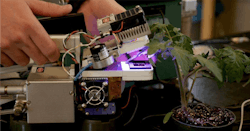“I am the Lorax. I speak for the trees. I speak for the trees for the trees have no tongues.”
― Dr. Seuss, The Lorax
Horticultural lighting technology has advanced more in the last five years than in the last several decades. LEDs have greatly increased energy efficiency over high-intensity discharge (HID) lights. Just as importantly, advanced LED fixtures, such as the TIGER Light developed at LESA, allow for multiple wavebands of light [most commonly ultraviolet A (UV-A), blue, green, red, and far red] and the ability to nearly instantaneously adjust the light output. Such fixtures allow for millions of combinations of light quality and quantity to be applied.
What has not kept pace with these technological advancements is our understanding of plant responses to light. As a plant scientist, I view my role as similar to the Lorax in the Dr. Seuss book. In this case, I am advocating for LED manufacturers to invest the time and money it takes to truly understand how plants will respond to these myriad of lighting regimes rather than take an “if we build it, the farmer will use it” approach. As of 2017, the US Department of Energy estimated that only 2% of lit area in greenhouses was with LEDs.1 A variety of factors are at play, including high upfront cost of new technology and reluctance to retrofit existing facilities, but also lack of knowledge of how to best use LED lights and the effects this will have on other production factors (temperature, irrigation, and CO2 supplementation and its effects on plant quality).
Enter the Greenhouse Lighting and Systems Engineering (GLASE) consortium, where our overall goal is to develop and demonstrate integrated technologies to reduce the energy used in horticultural lighting by 70% while preserving or enhancing crop quality. In GLASE, we carefully selected three model crops: lettuce as a vegetative (non-flowering/fruiting) crop with a short crop cycle, tomatoes as a fruiting crop that is the most economically important greenhouse vegetable in North America, and strawberries as a fruiting crop not yet commonly grown in greenhouses in the US.
Unlike what the Lorax said about the trees not being able to speak because they have no tongues, as plant scientists we know there are several ways to “listen” to the plant. One of these is to use a portable photosynthesis system to measure leaf response to light, temperature, and CO2 (Fig. 1). For example, in GLASE, we seek to more deeply understand the interaction between light intensity and CO2 for tomatoes and strawberries. This knowledge will be incorporated into a greenhouse control algorithm that decides when it is cost effective to enrich a controlled environment with CO2 to further boost the crop yield effect of supplemental light. Fig. 2 illustrates a light and CO2 response curve for photosynthesis of the strawberry crop “Albion,” which was taken with a portable photosynthesis system. The benefit of this tool is that it allows us to generate a graph (as in Fig. 2) on light and CO2 responses with about 30 minutes of data collection. In the case of this strawberry leaf, if we look at a light intensity of 500 µmol·m-2·d-1 (within the ball park of daytime light intensity in greenhouses) we find that there is a large benefit for photosynthesis when CO2 concentration is increased from 400 to 675 ppm, there is a smaller benefit for further increasing CO2 to 950 ppm, and no additional benefit of further increasing CO2. We also find for a single strawberry leaf at 400 ppm CO2, there is very little photosynthesis benefit of further increasing light intensity.
The constraints of these type of measurements are that they are just for one leaf, and while it gives us clues about how plant yield will respond to light and CO2, it doesn’t fully tell us what will happen in a full plant canopy for a whole crop cycle. To understand plant yield and fruit quality response, it is necessary to do longer-term trials. At Cornell University, we are currently setting up four greenhouse sections so as to deliver four different combinations of light and CO2 so we can observe yield and fruit quality responses over a whole crop cycle (Fig. 3). This brings us much closer to getting the full picture of plant responses. The last step of our research is to work with greenhouse operators to confirm responses at a commercial scale.
It’s an exciting time to be a plant scientist. Because horticultural LED lighting technology has advanced so quickly, we can deliver lighting treatments that plants would have never experienced in nature. By better understanding plant responses to light, we can harness this technology to produce high-quality products that require less energy.
REFERENCE
1. US Department of Energy, “Energy Savings Potential in SSL Horticultural Applications” (2017).
Get to know our expert
NEIL S. MATTSON joined Cornell University in 2007 and is currently an associate professor and greenhouse extension specialist in the School of Integrative Plant Science. His research is focused on the physiology of plants in controlled environments, including strategies to reduce greenhouse energy use, LED lighting, conventional and organic nutrient management, and plant abiotic stress physiology. Mattson is director of the Cornell Controlled Environment Agriculture group and an academic principle investigator in the GLASE consortium. He will be the Keynote speaker at the 2019 HortiCann Light + Tech conference. Join us on Oct. 31 in Denver, CO to hear this presentation among others.







